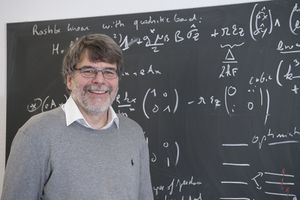Jerome Faist
Biography
The numerous direct and indirect collaborations between Jerome Faist and Frank K. Tittel have made quantum cascade laser (QCL) spectroscopy an established, more powerful, and versatile chemical detection tool for trace chemical sensing in environmental, medical, and security applications. Faist developed the QCL in 1994, providing a fundamentally new semiconductor laser that could operate in the mid-infrared and terahertz wavelength range. He then created the first single-mode laser suitable for spectroscopy in 1997. Faist has continuously advanced QCLs with innovations expanding the wavelength range, improving efficiency, developing theoretical models underpinning their properties, and expanding their applicability by improving room-temperature operation. Tittel had already been a leading researcher in several fields related to vibrational spectroscopy, especially in the development of new light sources and spectroscopy systems. With Faist’s invention of the QCL, Tittel was eager to the adapt the technology to environmental monitoring and medical diagnostics. In 2004, Faist supplied Tittel with one of the first QCLs cooled only by a thermoelectric cooler operating in the 9-µm region, which Tittel used to observe the absorptions of several species. Then Faist developed a broadly tunable QCL with an antireflection coating enabling external cavity tuning, which Tittel incorporated into a broad scanning source for his spectroscopic applications. One of the most important techniques developed in Tittel’s lab was quartz-enhanced photoacoustic spectroscopy (QEPAS). In this method, absorption of a modulated laser beam by a tiny sample of gas excites the resonance of a quartz tuning fork. By combining QEPAS with a QCL, Tittel produced a very compact and portable trace gas monitor with high sensitivity and stability that was readily deployable to the field. QCL-based sensors developed by Tittel have been shown to detect trace amounts of methane and nitrous oxide at landfills. Overall, Faist and Tittel have provided the global climate research community with tools to solve critical problems of unprecedented complexity.
An IEEE Member, Optical Society of America Fellow, and recipient of the 1994 American Association for the Advancement of Science’s Newcomb Cleveland Prize, Faist is a professor with the Department of Physics at ETH Zurich, Zurich, Switzerland.
